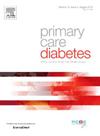2型糖尿病患者站立平衡障碍可通过周围神经病变和前庭病变进行预测。
IF 2.6
4区 医学
Q3 ENDOCRINOLOGY & METABOLISM
引用次数: 0
摘要
2型糖尿病的三个主要感觉并发症是糖尿病周围神经病变(DPN)、糖尿病视网膜病变(DR)和糖尿病前庭病变(DV)。目前对这些疾病的筛查发现不足,平衡测试可能是一种改进筛查方法的方法。本研究旨在评估是否存在感觉并发症可用于预测平衡评分。方法:招募52例T2D患者进行研究。记录参与者的人体测量、人口统计、社会经济和与参与者T2D相关的信息。参与者完成了改良的平衡感觉统合临床测试(mCTSIB)并记录分数。对与mCTSIB总平衡得分相关的所有变量进行双变量分析。在控制性别和年龄的情况下,以mCTSIB总分为结果,T2D感觉并发症为预测因子,建立多变量线性回归模型。结果:双变量分析显示显著(p 2 = 0.45,p )结论:T2D的感觉并发症具有预测平衡评分的潜力,并提供了平衡评估也可以筛查DPN和DV的第一个证据。本文章由计算机程序翻译,如有差异,请以英文原文为准。
Standing balance impairment in persons with type 2 diabetes is predicted by peripheral neuropathy and vestibulopathy
Introduction
The three main sensory complications of Type 2 Diabetes are diabetic peripheral neuropathy (DPN), diabetic retinopathy (DR), and diabetic vestibulopathy (DV). Current screening for these has been found to be insufficient, and balance testing may be a way to improve screening practices. This study aims to assess if the presence of sensory complications can be used to predict balance scores.
Methods
52 participants with T2D were recruited for this study. Participants anthropometric measures, demographic, socioeconomic, and information related to the participants T2D were recorded. Participants completed the modified Clinical Test of Sensory Integration in Balance (mCTSIB) and scores were recorded. Bivariate analysis was conducted on all variables related to mCTSIB total balance scores. A multivariable linear regression model was created using mCTSIB total scores as the outcome and T2D sensory complications as the predictor while controlling for sex and age.
Results
Bivariate analysis revealed significant (p < 0.05) associations between mCTSIB total scores and T2D sensory complications, education, employment, annual income, and age. The final multivariate linear regression model was found to be significant (Adj R2 = 0.45, p < 0.01). This model showed that those with DPN (β = 121.03 cm, CI = 77.71–164.35, p < 0.01) or DV (β: 60.65, CI = 5.17–116.13, p = 0.04) had significantly higher balance scores compared to those that did not have a sensory complication, adjusting for sex and age.
Conclusion
Sensory complications of T2D have the potential to predict balance scores and provides the first evidence that balance assessments may also be able to screen for DPN and DV.
求助全文
通过发布文献求助,成功后即可免费获取论文全文。
去求助
来源期刊

Primary Care Diabetes
ENDOCRINOLOGY & METABOLISM-PRIMARY HEALTH CARE
CiteScore
5.00
自引率
3.40%
发文量
134
审稿时长
47 days
期刊介绍:
The journal publishes original research articles and high quality reviews in the fields of clinical care, diabetes education, nutrition, health services, psychosocial research and epidemiology and other areas as far as is relevant for diabetology in a primary-care setting. The purpose of the journal is to encourage interdisciplinary research and discussion between all those who are involved in primary diabetes care on an international level. The Journal also publishes news and articles concerning the policies and activities of Primary Care Diabetes Europe and reflects the society''s aim of improving the care for people with diabetes mellitus within the primary-care setting.
 求助内容:
求助内容: 应助结果提醒方式:
应助结果提醒方式:


